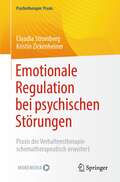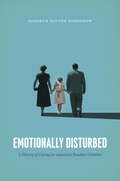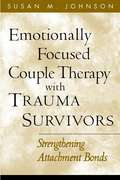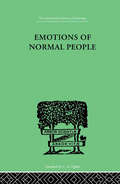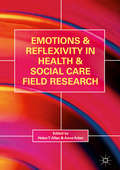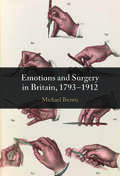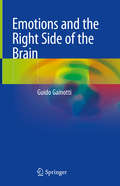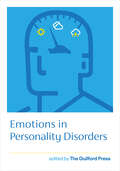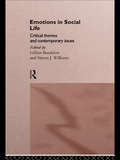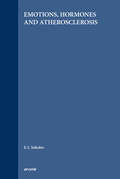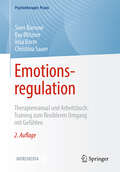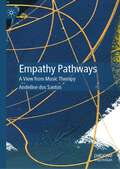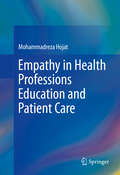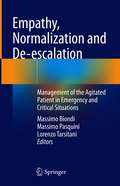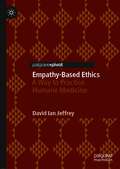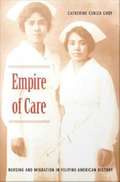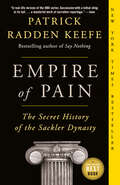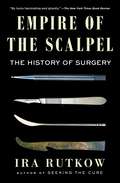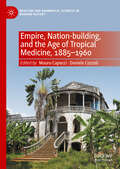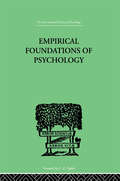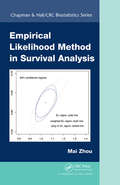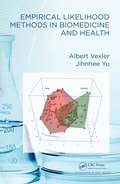- Table View
- List View
Emotionale Regulation bei psychischen Störungen: Praxis der Verhaltenstherapie schematherapeutisch erweitert (Psychotherapie: Praxis)
by Claudia Stromberg Kristin ZickenheinerDieses Buch zeigt Psychotherapeutinnen und -therapeuten, wie störungsspezifische Verhaltenstherapie durch transdiagnostisch wirksame Prozesse der Schematherapie angereichert werden kann. Besonders bei Behandelten mit niedrigem Funktionsniveau und schwierigen Therapieverläufen ist dieser duale Fokus entscheidend für einen nachhaltigen Behandlungserfolg. Im konzeptuellen Teil I wird der Erweiterungsbedarf u. a. entlang der Neuerungen von DSM-5 und ICD-11 und neurowissenschaftlicher Perspektiven beleuchtet und ein grundlegendes Konzept der Verzahnung von SORKC-Modell und schematherapeutischem Modusmodell entwickelt. Im praxisorientierten Teil II stellen wir die schematherapeutisch erweiterten Störungsmodelle und Behandlungspläne für ausgesuchte Störungen dar. Mit einem Geleitwort von Prof. Dr. Ulrich Schweiger. Aus dem Inhalt: Praxisorientierte Leitfäden zur Indikationsstellung und Prozesssteuerung – detaillierte Veranschaulichung der Modelle und Techniken – ausführliche Anleitung für Depression, Soziale Angststörung, GAS, Zwangsstörung, PTBS. Die Autorinnen: Dr. Claudia Stromberg, Psychologische Psychotherapeutin, Verhaltens- und Schematherapie. Dozentin und Supervisorin in Aus- und Fortbildung, Institutsleitung GAP Frankfurt, Co-Trainings-Director IST-F, Vorstandsmitglied des DVT. Dr. Kristin Zickenheiner, Psychologische Psychotherapeutin, Verhaltens- und Schematherapie. Dozentin und Supervisorin in Aus- und Fortbildung, tätig in eigener Praxis, ehem. Vorstandsmitglied ISST.
Emotionally Disturbed: A History of Caring for America's Troubled Children
by Deborah Blythe DoroshowBefore the 1940s, children in the United States with severe emotional difficulties would have had few options for care. The first option was usually a child guidance clinic within the community, but they might also have been placed in a state mental hospital or asylum, an institution for the so-called feebleminded, or a training school for delinquent children. Starting in the 1930s, however, more specialized institutions began to open all over the country. Staff members at these residential treatment centers shared a commitment to helping children who could not be managed at home. They adopted an integrated approach to treatment, employing talk therapy, schooling, and other activities in the context of a therapeutic environment. Emotionally Disturbed is the first work to examine not only the history of residential treatment but also the history of seriously mentally ill children in the United States. As residential treatment centers emerged as new spaces with a fresh therapeutic perspective, a new kind of person became visible—the emotionally disturbed child. Residential treatment centers and the people who worked there built physical and conceptual structures that identified a population of children who were alike in distinctive ways. Emotional disturbance became a diagnosis, a policy problem, and a statement about the troubled state of postwar society. But in the late twentieth century, Americans went from pouring private and public funds into the care of troubled children to abandoning them almost completely. Charting the decline of residential treatment centers in favor of domestic care–based models in the 1980s and 1990s, this history is a must-read for those wishing to understand how our current child mental health system came to be.
Emotionally Focused Couple Therapy with Trauma Survivors
by Susan M JohnsonThis book provides a theoretical framework and an innovative model of intervention for distressed couples whose relationships are affected by the echoes of trauma. Combining attachment theory, trauma research, and emotionally focused therapeutic techniques, Susan M. Johnson guides the clinician in modifying the interactional patterns that maintain traumatic stress and fostering positive, healing relationships among survivors and their partners. In-depth case material brings to life the process of assessment and treatment with couples coping with the impact of different kinds of trauma, including childhood abuse, serious illness, and combat experiences. The concluding chapter features valuable advice on therapist self-care.
Emotions Of Normal People (International Library Of Psychology Ser.)
by Marston, William MoultonFirst published in 1999. Routledge is an imprint of Taylor & Francis, an informa company.
Emotions and Reflexivity in Health & Social Care Field Research
by Helen T. Allan Anne ArberThis book is about emotions and reflexivity when doing field research in health and social care settings. Health and social care students often undertake field research in their own area of practice using observation and interviews. All contributing authors have a dual identity as researchers and health or social care professionals. Their chapters draw on research carried out in a number of fields including HIV related infertility and adoption, primary care in Africa, cancer and palliative care, infertility and excluded young people to explore issues relevant to emotions and reflexivity from the perspective of the researcher and research participants. The book was born of the two editors, who are experienced research supervisors, observing that many PhD students struggle to manage the emotions elicited in the field when researching. They identify three main causes - health and social care deals with painful topics; observation and interviews bring student into contact with powerful feelings which need processing; there is very little advice and discussion of how a PhD student manages emotions in the field and students therefore frequently struggle on their own. This insightful volume will be of great interest to scholars and students in all areas of academic study, but particularly to those who chose to study health and social care whether they are professionals or not.
Emotions and Surgery in Britain, 1793–1912
by Michael BrownIn this innovative analytical account of the place of emotion and embodiment in nineteenth-century British surgery, Michael Brown examines the changing emotional dynamics of surgical culture for both surgeons and patients from the pre-anaesthetic era through the introduction of anaesthesia and antisepsis techniques. Drawing on diverse archival and published sources, Brown explores how an emotional regime of Romantic sensibility, in which emotions played a central role in the practice and experience of surgery, was superseded by one of scientific modernity, in which the emotions of both patient and practitioner were increasingly marginalised. Demonstrating that the cultures of contemporary surgery and the emotional identities of its practitioners have their origins in the cultural and conceptual upheavals of the later nineteenth century, this book challenges us to question our perception of the pre-anaesthetic period as an era of bloody brutality and casual cruelty. This title is also available as open access.
Emotions and the Making of Psychiatric Reform in Britain, c. 1770-1820 (Palgrave Studies in the History of Emotions)
by Mark NeuendorfThis book explores the ways which people navigated the emotions provoked by the mad in Britain across the long eighteenth century. Building upon recent advances in the historical study of emotions, it plots the evolution of attitudes towards insanity, and considers how shifting emotional norms influenced the development of a ‘humanitarian’ temperament, which drove the earliest movements for psychiatric reform in England and Scotland. Reacting to a ‘culture of sensibility’, which encouraged tears at the sight of tender suffering, early asylum reformers chose instead to express their humanity through unflinching resolve, charging into madhouses to contemplate scenes of misery usually hidden from public view, and confronting the authorities that enabled neglect to flourish. This intervention required careful emotional management, which is documented comprehensively here for the first time. Drawing upon a wide array of medical and literary sources, this book provides invaluable insights into pre-modern attitudes towards insanity.
Emotions and the Right Side of the Brain
by Guido GainottiThis book focuses on asymmetries in brain structure and their role in emotional functions (such as amygdala in emotional comprehension, the ventro-medial prefrontal cortex in the integration between cognition and emotion and in the control of emotional reactions, and the anterior insula in the experience of emotions). The idea of hemispheric asymmetries in emotional comprehension and expression was first proposed about a century after the first studies showing that the left hemisphere is dominant for language, but it quickly became very popular. Initial investigations considered the right and left hemispheres as single functional units, but in the last few years several researchers have focused attention on asymmetries in brain structures playing a critical role in specific components of emotional functions. Furthermore, interesting data have been obtained by studying emotional and behavioural disorders of patients with asymmetrical forms of frontal or temporal variants of fronto-temporal degeneration. Elaborating on these subjects requires, on the one hand, a consolidated understanding of how models concerning the relationships between emotions and hemispheric asymmetries evolved in time and, on the other hand, a sound interdisciplinary knowledge of psychology (nature, components and hierarchical organization of emotions) and neuroscience (neuroanatomy). This volume – intended for neurologists, neuroscientists and psychologists – pursues an organic and consistent approach to provide an overview of these complex and fascinating issues.
Emotions in Personality Disorders
by The Guilford PressThis volume presents innovative clinical research programs and findings pertaining to emotions in personality disorders. Originally published in a Special Supplement of the Journal of Personality Disorders, chapters are written by a range of clinical experts. With a primary focus on borderline personality disorder (BPD), the book addresses such topics as personality function and emotional change in psychotherapy; how emotional dysregulation affects beliefs about emotion; shame as a core feature of BPD; the relationship between childhood adversity, affective lability, and alexithymia; and current directions in treatment.
Emotions in Social Life: Critical Themes and Contemporary Issues
by Simon J. Williams Gillian BendelowThe development of a sociology of emotions is crucial to our understanding of social life as they hold the key to our understanding of social processes and sociological investigation. First published in 1997, Emotions in Social Life consolidates the sociology of emotions as a legitimate and viable field of enquiry. It provides a comprehensive assessment of the sociology of emotions using work from scholars of international stature, as well as newer writers in the field. It presents new empirical research in conjunction with innovative and challenging theoretical material, and will be essential reading for students of sociology, health psychology, anthropology and gender studies.
Emotions, Hormones and Atherosclerosis
by SokolovThe increase of emotional stress has disturbing effects on the neurohumoral regulation of metabolic processes, especially in relation to the cardiovascular system, and increases the changes of organisms developing atherosclerosis. This book studies the effects on the cardiovascular system (in IHD patients) caused by emotions of diverse biological q
Emotionsregulation: Therapiemanual und Arbeitsbuch: Training zum flexibleren Umgang mit Gefühlen (Psychotherapie: Praxis)
by Sven Barnow Christina Sauer Eva Blitzner Insa BormMit diesem Manual bekommen Psychotherapeut_innen und Trainer_innen strukturierte Anweisungen an die Hand, um ein 9-wöchiges Training zur Förderung einer flexiblen Emotionsregulation durchzuführen. Neu in der zweiten Auflage: aktuelle Forschungsbefunde zur Emotionsregulation, Ergänzungen zur interpersonellen Emotionsregulation, entsprechende Anpassung der Gruppensitzungen und stärkerer Fokus auf das Training einer flexiblen Emotionsregulation. Die Anleitungen wurden zusätzlich mit praktischen Hinweisen angereichert. Aus dem Inhalt: Grundlagen flexibler Emotionsregulation – Gruppentraining in 9 Sitzungen mit Materialien – Training einzelner Regulationsstrategien – Evaluation – Abschluss und Booster. Das Autorenteam: Prof. Dr. phil. Sven Barnow, Leiter des Lehrstuhls für Klinische Psychologie und Psychotherapie, sowie der Psychotherapeutischen Hochschulambulanz an der Universität Heidelberg. Dr. phil. Eva Blitzner, Psychologische Psychotherapeutin (VT) in eigener Praxis für Psychotherapie und sozialmedizinische Gutachterin.Insa Borm, wissenschaftliche Mitarbeiterin in der Arbeitseinheit Klinische Psychologie und Psychotherapie an der Universität Heidelberg. Dr. Christina Sauer, Psychologische Psychotherapeutin (VT), wissenschaftliche Mitarbeiterin im Bereich der Psychoonkologie am Universitätsklinikum Heidelberg.
Empathie in de spreekkamer: Achtergronden, wetenschappelijke inzichten en praktische vaardigheden
by F.A.W.M. DerksenArtsen (in opleiding) richten zich steeds meer op persoonsgerichte zorg. Belangrijk onderdeel van die zorg is een goede communicatie met de patiënt. Huisarts Frans Derksen: “Uit gesprekken met patiënten, collegae huisartsen en wijkverpleegkundigen bleken veel problemen in de communicatie te ontstaan door een gemis aan empathie.” “Tijdens de jaren van onderzoek heb ik, als een soort bijwerking, veel geleerd over verschillende aspecten van het concept empathie. Veel van die aspecten passen niet in het keurslijf van een proefschrift maar vormen wel de inhoud van dit boek.” Ik wil laten zien waarom de thema’s rondom empathie een unieke waarde en een uniek belang hebben. Ik wil laten zien hoe dingen anders kunnen.” Dit boek bestaat uit een deel theorie, waarin wordt uitgelegd wat empathie is en wat de effecten zijn. Daarna wordt er een kort hoofdstuk gewijd aan empathie in verschillende medische, psychologische en sociale contexten. De kern van het boek vormen de vragen uit de praktijk, gesteld door de aios. Deel 4 bevat een beschouwing over hoe empathie in het vak en in het onderwijs gebruikt kan worden.
Empathy Pathways: A View from Music Therapy
by Andeline dos SantosMany descriptions of empathy revolve around sharing in and understanding another person’s emotions. One separate person gains access to the emotional world of another. An entire worldview holds up this idea. It is individualistic and affirms the possibility of access to other people’s “inner world.” Can we really see inside another, though? And are we discrete, separate selves? How can we best grapple with these questions in the field of music therapy? In response, this book offers four empathy pathways. Two are situated in a constituent approach (that prioritises discrete individuals who then enter into relationships with one another) and two are located in relational approaches (that acknowledge the foundational reality of relationships themselves). By understanding empathy more fully, music therapists, teachers and researchers can engage in ways that are congruent with diverse worldviews and ways of being. Examples used in the book are from active and receptive music therapy approaches as well as from community and clinical contexts, so as to provide clear links to practice. This book will be a valuable resource for academics and postgraduate students within music therapy and allied fields including art therapy, drama therapy, dance/movement therapy, psychology, counselling, occupational therapy and social development studies.
Empathy in Health Professions Education and Patient Care
by Mohammadreza HojatThis welcome updated and expanded edition offers new findings and insights into this cornerstone of practice as well as effective tools for its clinical use. Spanning psychodynamic theory to neuroscience and evolution to medicine, the book defines empathy in the context of patient care, and both in its critical role as a human attribute and in its necessity in promoting change and healing. Theory and data link practitioner empathy with patients' positive outcomes in areas such as provider trust, treatment adherence, clinical improvements, and quality of life. Author also provide convincing evidence in support of validity and reliability of the Jefferson Scale of Empathy for measuring the empathy of practitioners and students in the healing professions, and detail obstacles to developing and strategies for enhancing empathy among care providers. Among the topics covered: * Definition of empathy in patient care. * Conceptualization and consequences of empathy and sympathy in patient care. * An evolutionary perspective, sociophysiology, and heritability of empathy. * Measurement of empathy in the general population and in health professions-in-training, and in-practice. * Interpersonal dynamics in clinician-patient relationships. * Ten approaches to enhance empathy in Health professions education and patient care. * Exploration of neurological underpinnings of empathy. * Plus in-depth discussion of development, psychometrics, and correlates of the Jefferson Scale of Empathy. An essential text in theory and applications, Empathy in Health Professions Education and Patient Care enhances the work of health professions students, faculty, and practitioners in a variety of disciplines such as medicine, nursing, dentistry, psychology, clinical social work, and other health professions.
Empathy, Normalization and De-escalation: Management of the Agitated Patient in Emergency and Critical Situations
by Massimo Biondi Massimo Pasquini Lorenzo TarsitaniThis book describes theory and techniques of empathic communication, normalization and de-escalation procedures for the management of aggressive or violent patients in clinical critical settings'. Consisting of 9 chapters, it discusses in detail the self-regulation of empathy in potential dangerous interactions, as well as common mistakes and nonprofessional reactions. It also explores the basic concept of neurobiology of violence and aggression behaviour, such as brain circuitry and neuromodulators, and other rapid tranquillization guidelines. The final chapter focuses on the crucial topics of post-aggression debriefing.Based on the clinical experience of the editors and authors, who work in emergency psychiatry settings, the book offers practical key expressions to promote a normalization talk, to calm agitated individuals, and to prevent crises both for psychiatric patients and people without mental disorders.It is a useful tool to help readers gain confidence as mediators in critical circumstances and will be of interest for a wide range of practitioners in healthcare settings, from psychiatrists and psychologists, to nurses and other healthcare workers.
Empathy-Based Ethics: A Way to Practice Humane Medicine
by David Ian JeffreyThis book explores a new way of applying clinical ethics. Empathy-based ethics is based on the patient–doctor relationship and seeks to encourage a more humane form of medical practice. The author argues that the current emphasis on the biomedical model of medicine and a detached concern form of professionalism have damaged the patient–doctor relationship. He investigates examples of the dehumanization of patients and demonstrates a contrasting view of humane care. The book presents empathy as a relational construct - it provides an in-depth analysis of the process of empathizing. It discusses an empathy-based ethics approach underpinned by clinical examples of the practical application of this new approach. It suggests how empathy-based ethics can be embedded in clinical practice, medical education and research. The book concludes by examining the challenges in implementing such an approach and looks to a future which redresses the current imbalance between biomedical and psychosocial approaches to medicine.
Empire of Care: Nursing and Migration in Filipino American History
by Catherine Ceniza ChoyIn western countries, including the United States, foreign-trained nurses constitute a crucial labor supply. Far and away the largest number of these nurses come from the Philippines. Why is it that a developing nation with a comparatively greater need for trained medical professionals sends so many of its nurses to work in wealthier countries? Catherine Ceniza Choy engages this question through an examination of the unique relationship between the professionalization of nursing and the twentieth-century migration of Filipinos to the United States. The first book-length study of the history of Filipino nurses in the United States, Empire of Care brings to the fore the complicated connections among nursing, American colonialism, and the racialization of Filipinos. Choy conducted extensive interviews with Filipino nurses in New York City and spoke with leading Filipino nurses across the United States. She combines their perspectives with various others--including those of Philippine and American government and health officials--to demonstrate how the desire of Filipino nurses to migrate abroad cannot be reduced to economic logic, but must instead be understood as a fundamentally transnational process. She argues that the origins of Filipino nurse migrations do not lie in the Philippines' independence in 1946 or the relaxation of U. S. immigration rules in 1965, but rather in the creation of an Americanized hospital training system during the period of early-twentieth-century colonial rule. Choy challenges celebratory narratives regarding professional migrants' mobility by analyzing the scapegoating of Filipino nurses during difficult political times, the absence of professional solidarity between Filipino and American nurses, and the exploitation of foreign-trained nurses through temporary work visas. She shows how the culture of American imperialism persists today, continuing to shape the reception of Filipino nurses in the United States.
Empire of Pain: The Secret History of the Sackler Dynasty
by Patrick Radden KeefeThe highly anticipated portrait of three generations of the Sackler family, by the prize-winning, bestselling author of SAY NOTHING The Sackler name adorns the walls of many storied institutions: Harvard, the Metropolitan Museum of Art, Oxford, the Louvre. They are one of the richest families in the world, known for their lavish donations to the arts and sciences. The source of the family fortune was vague, however, until it emerged that the Sacklers were responsible for making and marketing OxyContin, a blockbuster painkiller that was a catalyst for the opioid crisis. Empire of Pain is a masterpiece of narrative reporting and writing, exhaustively documented and ferociously compelling.
Empire of Pain: The Secret History of the Sackler Dynasty
by Patrick Radden KeefeNEW YORK TIMES BESTSELLER • A NEW YORK TIMES NOTABLE BOOK OF THE YEAR • A grand, devastating portrait of three generations of the Sackler family, famed for their philanthropy, whose fortune was built by Valium and whose reputation was destroyed by OxyContin. From the prize-winning and bestselling author of Say Nothing."A real-life version of the HBO series Succession with a lethal sting in its tail…a masterful work of narrative reportage.&” – Laura Miller, Slate The history of the Sackler dynasty is rife with drama—baroque personal lives; bitter disputes over estates; fistfights in boardrooms; glittering art collections; Machiavellian courtroom maneuvers; and the calculated use of money to burnish reputations and crush the less powerful. The Sackler name has adorned the walls of many storied institutions—Harvard, the Metropolitan Museum of Art, Oxford, the Louvre. They are one of the richest families in the world, but the source of the family fortune was vague—until it emerged that the Sacklers were responsible for making and marketing a blockbuster painkiller that was the catalyst for the opioid crisis.Empire of Pain is the saga of three generations of a single family and the mark they would leave on the world, a tale that moves from the bustling streets of early twentieth-century Brooklyn to the seaside palaces of Greenwich, Connecticut, and Cap d&’Antibes to the corridors of power in Washington, D.C. It follows the family&’s early success with Valium to the much more potent OxyContin, marketed with a ruthless technique of co-opting doctors, influencing the FDA, downplaying the drug&’s addictiveness. Empire of Pain chronicles the multiple investigations of the Sacklers and their company, and the scorched-earth legal tactics that the family has used to evade accountability.A masterpiece of narrative reporting, Empire of Pain is a ferociously compelling portrait of America&’s second Gilded Age, a study of impunity among the super-elite and a relentless investigation of the naked greed that built one of the world&’s great fortunes.
Empire of the Scalpel: The History of Surgery
by Ira RutkowFrom a renowned surgeon and historian with five decades of experience comes a remarkable history of surgery&’s development—spanning the Stone Age to the present day—blending meticulous medical studies with lively and skillful storytelling.There are not many events in life that can be as simultaneously life-frightening and life-saving as a surgical operation. Yet, in America, tens-of-millions of major surgical procedures are performed annually but few of us pause to consider the magnitude of these figures because we have such inherent confidence in surgeons. And, despite passionate debates about healthcare and the endless fascination with surgical procedures, most of us have no idea how surgeons came to be because the story of surgery has never been fully told. Now, Empire of the Scalpel elegantly reveals the fascinating history of surgery&’s evolution from its earliest roots in Europe through its rise to scientific and social dominance in the United States. From the 16th-century saga of Andreas Vesalius and his crusade to accurately describe human anatomy while appeasing the conservative clergy who clamored for his burning at the stake, to the hard-to-believe story of late-19th century surgeons&’ apathy to Joseph Lister&’s innovation of antisepsis and how this indifference led to thousands of unnecessary surgical deaths, Empire of the Scalpel is both a global history and a uniquely American tale. You&’ll discover how in the 20th century the US achieved surgical world supremacy heralded by the Nobel Prize–winning, seemingly impossible feat of transplanting a kidney and how the heart-lung machine was developed, along with much more. Today, the list of possible operations is almost infinite—from knee and hip replacement to heart bypass and transplants to fat reduction and rhinoplasty—and Rutkow draws on his five-decade career to show us how we got here. Authoritative, captivating, and comprehensive, Empire of the Scalpel portrays the evolution of surgery in all its dramatic and life-enhancing complexity and shows that its history is truly one awe-inspiring triumph after another.
Empire, Nation-building, and the Age of Tropical Medicine, 1885–1960 (Medicine and Biomedical Sciences in Modern History)
by Mauro Capocci Daniele CozzoliThis book investigates the complex relationship between the development of modern empires, nation, and the history of tropical medicine. Broadening existing historiographical perspectives, it explores imperialism outside of the British Empire, drawing on case studies from other colonial experiences in Africa, Asia, and South America in the late-nineteenth and early-twentieth century. Each of these systems adopted different approaches to colonial health and medicine. By studying their diversity, it is possible to obtain a more comprehensive picture of what we now call ‘tropical medicine.’ The authors emphasise that the British model cannot be adapted to all colonial experiences, drawing on relevant cases from both interoceanic and continental empires. The collection comprises three sections. The first examines the role of tropical medicine in the evolution and collapse of empire in countries such as Portugal and the Netherlands. The second part analyses the links between tropical medical institutions and imperial commercial and political expansion in Britain and Brazil. Finally, the authors tackle the crucial interrelated circulation of people, objects, and ideas amongst countries including Brazil, China, Italy, and Spain. Using a medical lens to analyse the inter-connected processes of nation-building and colonial expansion in the late-nineteenth and early-twentieth centuries, this book provides valuable reading for scholars of imperialism and medical history alike.
Empirical Foundations Of Psychology (International Library Of Psychology Ser.)
by Pronko, N H & Bowles, J WFirst published in 1999. Routledge is an imprint of Taylor & Francis, an informa company.
Empirical Likelihood Method in Survival Analysis
by Mai ZhouEmpirical Likelihood Method in Survival Analysis explains how to use the empirical likelihood method for right censored survival data. The author uses R for calculating empirical likelihood and includes many worked out examples with the associated R code. The datasets and code are available for download on his website and CRAN.The book focuses on all the standard survival analysis topics treated with empirical likelihood, including hazard functions, cumulative distribution functions, analysis of the Cox model, and computation of empirical likelihood for censored data. It also covers semi-parametric accelerated failure time models, the optimality of confidence regions derived from empirical likelihood or plug-in empirical likelihood ratio tests, and several empirical likelihood confidence band results.While survival analysis is a classic area of statistical study, the empirical likelihood methodology has only recently been developed. Until now, just one book was available on empirical likelihood and most statistical software did not include empirical likelihood procedures. Addressing this shortfall, this book provides the functions to calculate the empirical likelihood ratio in survival analysis as well as functions related to the empirical likelihood analysis of the Cox regression model and other hazard regression models.
Empirical Likelihood Methods in Biomedicine and Health
by Albert Vexler Jihnhee YuEmpirical Likelihood Methods in Biomedicine and Health provides a compendium of nonparametric likelihood statistical techniques in the perspective of health research applications. It includes detailed descriptions of the theoretical underpinnings of recently developed empirical likelihood-based methods. The emphasis throughout is on the application of the methods to the health sciences, with worked examples using real data. Provides a systematic overview of novel empirical likelihood techniques. Presents a good balance of theory, methods, and applications. Features detailed worked examples to illustrate the application of the methods. Includes R code for implementation. The book material is attractive and easily understandable to scientists who are new to the research area and may attract statisticians interested in learning more about advanced nonparametric topics including various modern empirical likelihood methods. The book can be used by graduate students majoring in biostatistics, or in a related field, particularly for those who are interested in nonparametric methods with direct applications in Biomedicine.
